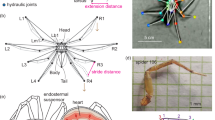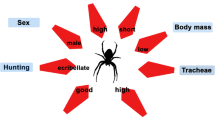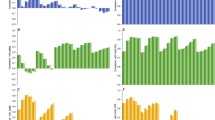Summary
-
1.
A non-invasive, laser/fibre-optic, technique was developed to measure the heartrates of active unrestrained spiders. The heart-rates of 15 species were measured before, during and after activity.
-
2.
Maximum heart-rate varied between species. A possible association between maximum heartrate and prey-catching behaviour is proposed. Within a species, body-weight had no significant effect on maximum heart-rate. InArgyroneta, mature males had significantly higher maximum heart-rates than mature females.
-
3.
Spiders possessing prosomal tracheae had significantly lower maximum heart-rates than spiders with tracheae limited to the abdomen. The effects of low heart-rates on haemolymph circulation, during locomotion, are discussed.
-
4.
The hearts of all the spiders studied were capable of maintaining pumping during locomotion. Forced fast running was associated with a lowering of the heart-rate: heart-rates decreased at the onset of running and a rise occurred when activity ceased. A rise in heart-rate also occurred as soon as voluntary locomotion ceased.
-
5.
After exercise, recovery of the heart-rate to it's pre-exercise level was faster inArgyroneta than inTrochosa. It is suggested that gas exchange is more efficient in spiders with prosomal tracheae than in spiders with tracheae limited to the abdomen.
-
6.
In both active and inactiveDysdera, it appears that the volume of haemolymph pumped posteriorly by the heart varies, rhythmically in inactive spiders. It is suggested that an increased haemolymph flow posteriorly coincides with a raised pressure gradient into the prosoma which inhibits the heart from pumping haemolymph anteriorly.
Similar content being viewed by others
References
Anderson JF (1970) Metabolic rates of spiders. Comp Biochem Physiol 33:51–72
Anderson JF, Prestwich KN (1975) The fluid pressure pumps of spiders (Chelicerata, Araneae). Z Morphol Tiere 81:257–277
Anderson JF, Prestwich KN (1982) Respiratory gas exchange in spiders. Physiol Zool 55:72–90
Anderson JF, Prestwich KN (1985) The physiology of exercise at and above maximal aerobic capacity in a theraphosid (tarantula) spider,Brachypelma smithi (F. O. Pickard-Cambridge). J Comp Physiol B 155:529–539
Angersbach D (1978) Oxygen transport in the blood of the tarantulaEurypelma californicum: pO2 and pH during rest, activity and recovery. J Comp Physiol 123:113–125
Bristowe WS (1958) The world of spiders. The new naturalist series, Collins, London
Bristowe WS, Millot J (1932) Liphistiid spiders. Proc Zool Soc (London) 1932:1015–1057
Carrel JE (1987) Heart rate and physiological ecology. In: Nentwig W (ed) Ecophysiology of spiders. Springer, Berlin Heidelberg New York, pp 95–110
Carrel JE, Heathcote RD (1976) Heart rate in spiders: influence of body size and foraging energetics. Science 193:148–150
Cloudsley-Thompson JL (1957) Studies in diurnal rhythms.-V. Nocturnal ecology and water-relations of the British cribellate spiders of the genusCiniflo Bl. J Linn Soc Zool 43:134–152
Drury RAB, Wallington EA (eds) (1967) Carleton's histological technique, 4th edn. Oxford University Press
Ellis CH (1944) The mechanism of extension in the legs of spiders. Biol Bull 86:41–50
Finck A (1982) Gravito-inertial sensitivity of the spider:Araneus sericatus. The Physiologist 25 [Suppl]:121–122
Foelix RF (1982) Biology of spiders Harvard University Press, Cambridge (Mass.) London
Gonzales-Fernandez F, Sherman RG (1984) Cardioregulatory nerves in the spiderEurypelma marxi Simon. J Exp Zool 231:27–37
Greenstone MH, Bennett AF (1980) Foraging strategy and metabolic rate in spiders. Ecology 61:1255–1259
Herreid II CF (1981) Energetics of pedestrian arthropods. In: Herreid II CF, Fourtner CR (eds) Locomotion and energetics in arthropods. Plenum Press, New York London, pp 491–526
Hill DE (1977) Some observations on the physiology of livingLyssomanes viridis which should apply to the Araneae in general. Peckhamia 1:41–44
Levi HW, Kirber WM (1976) On the evolution of tracheae in arachnids. Bull Br Arachnol Soc 3:187–188
Linzen B, Gallowitz P (1975) Enzyme activity patterns in muscles of the lycosid spiderCupiennius salei. J Comp Physiol 96:101–109
Martin AW, Johansen KJ (1965) Adaptations of the circulation in invertebrate animals. In: Hamilton WF, Dow P (eds) Handbook of physiology — a critical, comprehensive presentation of physiological knowledge and concepts. Sec 2 (circulation), Vol III. American Physiological Society, Washington DC, pp 2545–2581
Parry DA (1957) Spider leg-muscles and the autotomy mechanism. Quart J Micr Sci 98:331–340
Parry DA, Brown RHJ (1959) The hydraulic mechanism of the spider leg. J Exp Biol 36:423–433
Paul R, Fincke T, Linzen B (1987) Respiration in the tarantulaEurypelma californicum: evidence for diffusion lungs. J Comp Physiol B 157:209–217
Petrunkevitch A (1909) Contributions to our knowledge of the anatomy and relationships of spiders. Ann Ent Soc Am 2:11–21
Petrunkevitch A (1933) An inquiry into the natural classification of spiders, based on a study of their internal anatomy. Trans Conn Acad 31:299–389
Prestwich KN (1983a) Anaerobic metabolism in spiders. Physiol Zool 56:112–121
Prestwich KN (1983b) The roles of aerobic and anaerobic metabolism in active spiders. Physiol Zool 56:122–132
Sherman RG, Pax RA (1968) The heartbeat of the spiderGeolycosa missouriensis. Comp Biochem Physiol 26:529–536
Snedecor GW, Cochran WG (1967) Statistical methods, 6th edn. Iowa State University Press
Stewart DM, Martin AW (1974) Blood pressure in the tarantula,Dugesiella hentzi. J Comp Physiol 88:141–172
Wasserthal LT (1980) Oscillating haemolymph ‘circulation’ in the butterflyPapilio machaon L. revealed by contact thermography and photocell measurements. J Comp Physiol 139:145–163
Wilson RS (1965) The pedicel of the spiderHeteropoda venatoria. J Zool 147:38–45
Wilson RS (1967) The heart-beat of the spiderHeteropoda venatoria. J Insect Physiol 13:1309–1326
Wilson RS (1970) Some comments on the hydrostatic system of spiders (Chelicerata, Araneae). Z Morphol Tiere 68:308–322
Wilson RS, Bullock J (1973) The hydraulic interaction between prosoma and opisthosoma inAmaurobius ferox (Chelicerata, Araneae). Z Morphol Tiere 74:221–230
Author information
Authors and Affiliations
Rights and permissions
About this article
Cite this article
Bromhall, C. Spider heart-rates and locomotion. J Comp Physiol B 157, 451–460 (1987). https://doi.org/10.1007/BF00691829
Accepted:
Issue Date:
DOI: https://doi.org/10.1007/BF00691829




